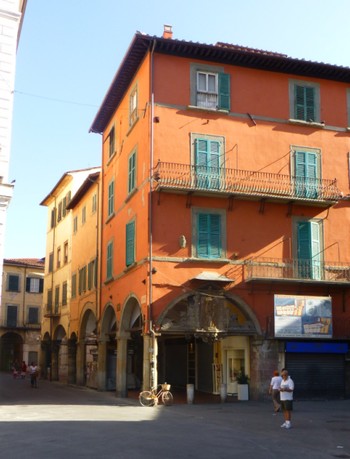Introduction
An interesting environment for investigating the history of playing cards and card games in Tuscany is that of the academies, which were active as private institutions involving a relatively small part of the citizens. In several cases, the main activity of the fellows involved was that of organising performances of comedies or music dramas.
This activity flourished in Florence and in other Tuscan towns in the course of centuries, with pioneering aspects, and has been recurrently studied by several historians. In every treatise on the history of the European theatre it will be easy to find some information on these aspects.
Less studied is the parallel activity of the organisation of parties, celebrations and dances, which became widespread in the 19th century. However, an extensive study has been devoted to this subject too;(1) it is precisely focused on the 19th century, and Pisa is probably the deepest investigated among the Tuscan towns.
Again for Pisa, whole monographs have been published specifically devoted to the Casino dei Nobili. Just as an indication, let me refer to Panaja’s documented book.(2)
Much less investigated has been the playing activity, and especially the card playing activity, that was often combined in the same places. In the books mentioned, many descriptions can be found on the events that occurred in Casino dei Nobili of Pisa.
What is reported in this note is however some earlier information, coming from a time in which the previous Casino dei Gentiluomini of Pisa existed, between 1691 and 1726, as a weakly-established institution of the town.
All the new information only derives from the study of an individual register, kept in the Archivio di Stato di Pisa, ASPi. Some information on the ASPi can be found in a previous note and will not be repeated here.(3)
Register Roncioni 362
It is rather by chance that a register of the administration of the Casino dei Gentiluomini has been preserved within a family archive, the Roncioni archive, which has been deposited into the ASPi. In the corresponding inventory, Number 62, we read: 362 Casino dei Nobili. Entrata e Uscita 1692 – 1707.(4) It appears to be the only register of its kind in the whole family archive.
Actually, the time interval covered is more extended than indicated in the inventory, and we can consider that this small register contains the records of the relevant data for the whole time of activity of the Casino, from 1691 to 1726, even if the records are structured in different ways.
The register is relatively small, with dimensions 21x29 cm (thus just a bit shorter than our A4 format) and hardly 1 cm thick. It contains 57 folios numbered with a pencil. It has a papier-mache cover with a vellum paper jacket. The title written on the cover is “Del Casino. Entrata e uscita delli Illus.mi Sig.ri Gentiluomini della Città di Pisa”.
It is evident that the compiler, or a manager of the institution, kept this register among the documents of his family, when the Casino was closed. (We also find a member of the Roncioni family among the founding members of the Casino.)
The register is divided into different sections, first the incomes, followed by the expenses, which occupy ff. 24v-51v, and some records of packs present in the Casino at various times in ff. 54r-57r.
At the beginning we find on f. 1v a list of the eighteen founding members, with their individual share of L.8 s.12 d.4 for a total initial deposit of L.155 s.2.
The initial part of the register, up to f. 10v corresponding to January 1707, contains detailed lists of incomes. They almost exclusively consist in the money found in the cashbox, in which fees were always deposited for playing. However, some additional information on playing cards may be derived from the sale of used packs, and a list for these items will be added below as a second appendix.
On f. 11r we read that on 31 July 1715 Giuseppe Cestellini from Pisa was appointed as manager. For some years earlier on, and then up to f. 20v, of the year 1726, we find in the register records for the Casino administration, with no longer a sharp distinction between incomes and expenses.
The last information is not suitable for our aims. Playing cards are still quoted, but the corresponding amounts in terms of packs and prices is no longer provided: we only find the cumulative money amounts for various items and time intervals. Often the corresponding expenses were refunded to the manager, together with his salary, without any further specification or detail.
Our interest is focuses on the expenses of the first years, with lists beginning on f. 24v. Reasonably, our interest is limited to the playing cards, and we can thus neglect all the frequent records of purchases of oil, wax furniture, or particular objects required for the functioning of the Casino, in addition to repair works, and salaries and gratuities given to the servants.
The dates
In the records copied below, some changes of the years, as actually written in the register, have been introduced. As in Florence, the New Year was celebrated in Pisa on 25 March, corresponding to Christ’s Incarnation. However, the way of labelling the years was in Pisa postponed by exactly one whole year in comparison to Florence.
The result is that we have to behave differently, when adapting the dates of the documents from Pisa to our common habit of beginning each year on 1 January. In Florence, we could keep all the dates from 25 March to 31 December unchanged and had to add one year from 1 January to 24 March. In Pisa, the contrary occurs: we have to keep the dates from 1 January to 24 March unaltered, and to change into one year less those from 25 March to 31 December.
My intention has been to follow the last indication in every case, so that all the dates in the following text should conform, errors excepted, to our common habit of changing the year number on 1 January.
The Casino rooms
We find a loose sheet in the register under examination with a lease contract for the three rooms on the first floor of a building above the Seven Columns in Piazza del Ponte, where the Casino fellows gathered: “il primo piano d’una sua casa posta su la Piazza del Ponte sopra alle Sette Colonne di N. 3 stanze dove di presente si fa il Casino per li Gentiluomini.”
The place was a very remarkable one, directly in front of the main bridge on the Arno river. In front, on the left bank of the river in correspondence to the other end of the bridge, the Logge dei Banchi had been built one century before, with the intention to provide an architectural pre-eminence to that central area.
Exactly the same intention will conduct later on to a new palace on the right bank of our interest, just on the other side of Borgo Stretto, where the Casino was established again in 1754 in its improved form.
From the loose sheet, we learn the lease terms too, and in particular that the rent money was 24 ducats per year, which is confirmed by two six-monthly instalments of L. 84 that we regularly find recorded on 1 June and 1 December among the expenses. (At the time, one ducat was rated 7 Liras.)
Curiously enough, we find an unusual clause added at the end of this contract: it shall be considered null and void as soon as any new official pronouncement interdicts to play there.
The landlord was Giovanni Mannoni – from the receipts we realise that he was not able to write or sign the documents, and that he was somehow involved with the activity of the Casino; in particular, we occasionally find that dozens of packs of second-hand cards from the Casino were sold out precisely to him.
Kinds of games
A general comment on the context has to consider that card playing was seldom authorised at the time. A licence to play Minchiate was easier to obtain, but any gambling games played in a Casino for the nobility were hard if not impossible to control by the guards. We are thus rather uncertain about the kind of games preferred by those players.
For a trustful reconstruction of that milieu we can refer to the assessment of the scholar, who possibly has studied it more than anybody else.
“Il primo circolo nobiliare toscano ad essere saldamente inserito nel quadro statale fu probabilmente il Nuovo Casino dei nobili di Pisa fondato nel 1754. Prima di allora i nobili pisani ebbero come ritrovo esclusivo alcuni locali posti al primo piano del palazzo delle Sette colonne, in piazza del Ponte: un circolo autofinanziato che i frequentatori, con un po’ di pretenzione, battezzarono Casino dei Gentilhuomini. Si trattava in realtà di una semplice bisca riservata ai maschi del ceto dirigente che non poteva reggere il paragone con i casini nobiliari delle altre città toscane.”(5)
Summarising, only with the rebirth of the Casino in the second half of the 19th century Pisa obtained a suitable meeting place for ladies and gentlemen, comparable to those existing in other Tuscan towns – in the years considered here, the institution in Pisa was nothing else than a trivial gambling house for gentlemen.
What we will see from the cards employed is somewhat less severe; in particular, Minchiate were clearly still played there frequently, which is not the best indication for any gamblers’ activity.
Kinds of cards
By far the commonest game tools found in the Casino dei Gentiluomini are playing cards. It may be somewhat surprising that we find only two kinds of them, typically indicated as either Basse or Alte. There are a few exceptions in these records, in which one reads instead just Carte, or expressly Minchiate. After carefully checking, I have concluded that there was no reason to specify these few cases in my transcription, because I am convinced that Carte Alte was nothing else than an alternative expression for Minchiate, whereas the simple denomination of Carte was here intended for Carte Basse.
The two kinds of cards were priced at about L. 1 s. 5 or somewhat lower for a pack of Basse and slightly less than 2 L. for one of Minchiate. As usual for centuries, only taking the packs by the dozens one could find prices indicated by whole numbers of Liras. For a dozen packs of ordinary cards, together with a common price of L. 15, we find L. 14 and L. 16 too, and further values occasionally. For a dozen Minchiate packs, the most frequent price was L. 23.
All these cards were manufactured in Florence, but could usually be acquired in Pisa. Only in a few cases, we read in the corresponding records that the cards directly came from Florence. This additional information is indicated in the tables by inserting an F after the date.
That Minchiate was the only kind of tarot-like cards present is not surprising, because this is in agreement with everything that we know from other Tuscan towns (even if the date is here relatively early for finding enough specimens to compare). A little more surprising is the apparent absence of other card packs. If this really was a gambling house, as often suggested, different packs could be suitable for playing new or foreign games with higher stakes.
Yearly purchases of playing cards
The records in the register corresponding to card purchases have been fully reported in the appendix. In the following table, one finds just the yearly amounts of all card packs acquired; they have been calculated from the records copied in the appendix, and may be only partially correct.
The amounts in the three last rows, within brackets, derive from entries recorded with less detail. Further inaccuracy can derive from the circumstance that in the original register several numbers are unclearly written, and several pages have the text remarkably faded.
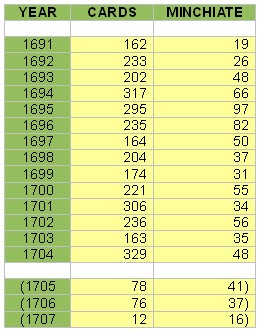
As in similar cases, these numbers are interesting in themselves, in every detail. We can however take as a useful indication the average number of packs for each year. The values thus obtained are roughly 50 and 200 for Minchiate and cards, respectively. There are remarkable deviations in some years, but in any case we can easily conclude that the consumption of Minchiate was far from negligible.
A significant additional value that is worth mentioning is the ratio between Minchiate and ordinary cards. The ratio of the average values indicated above is about 25%. In Pisa, the fraction of Minchiate is thus higher than one could expect in any Tuscan town, except for Florence itself.
The Casino activity
In considering the activity of the Nuovo Casino, established in 1754, we are in front of a rather common situation in the main Tuscan towns of the time. The activity included then card playing, but the main events were fests and dances, in which the ladies of the town were at the centre of the attention.
On the contrary, the previous Casino dei Gentiluomini, which we are studying here, had a much more limited activity: only open to gentlemen and with the main occupation consisting in playing card games. It is thus not surprising that our historians quickly deal with this milieu as with a gambling house, unworthy of a special attention.
This however occurs just because this Casino was not located… in London, where it could have represented the first or at least one of the first gentlemen’s clubs, which later on determined a real vogue throughout the world.
Moreover, it is far from clear that the main activity of the club was that of gambling. If you play Minchiate, you can gamble at the same time, typically playing for high stakes, or even cheating – but this does not appear as the most direct way to do it.
Among the expenses, we find on 4 June 1691 the record of four tin dishes, acquired for the card game of Hombre, or Ombre as it was named here. This again is not the most suitable selection for a gambling game.
We also have further evidence of the playing environment, coming from the presence of other playing sets, to begin with sbaraglino, a kind of backgammon which was much played at the time, as nearly a family game.
CONCLUSION
New quantitative information has been reported on the card packs acquired for the Casino dei Gentiluomini in Pisa, during the years 1691-1707. This time interval is rather early for similar documents.
At the time, the Casino was not yet a prestigious institution at the town level and was rather considered as a gambling house, in which it was possible to play games that were not allowed in other places, and for higher stakes.
Nevertheless, the amount of Minchiate packs exploited there, together with further hints, can suggest a different view of the situation. There, the favourite Florentine game was apparently widely played at the time, and it does not really belong to the gambling kinds.
Footnotes:
(1) Andrea Addobbati, La festa e il gioco nella Toscana del Settecento. Pisa 2002.
(2) Alessandro Panajia, Il casino dei nobili. Pisa 1996.
(3) Franco Pratesi: 17XX – A CARD GAME IN PISA (2012)
(4) Archivio di Stato di Pisa: Patrimonio documentario
(5) From ref. (1), p. 202.
|
Once a place
for
Minchiate
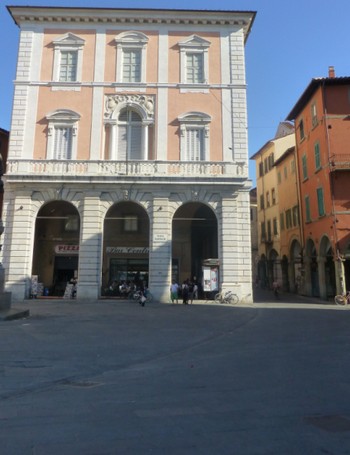
The bridge on the Arno river is not shown, it is behind the point of view.
The name of the place is now Piazza Garibaldi.
In the big white palace was located Casino dei Nobili, opened in 1754.
Casino dei Gentiluomini was instead located in the building on the right, separated by the small street, Borgo Stretto. The “seven columns” can be seen in Borgo Stretto, at its beginning. They do not correspond to one palace, but to three adjacent buildings.
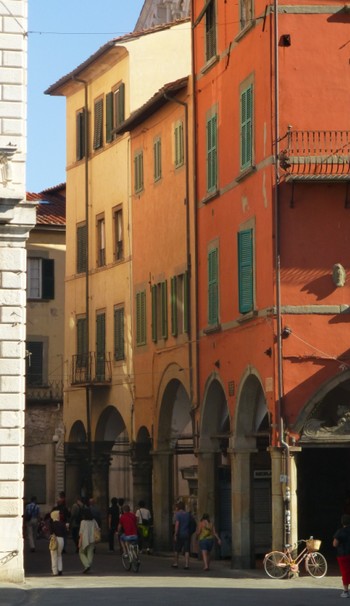
Counting the Numbers
In our talk Franco warned me, that sum and per cent amounts may be somewhat wrong, due to missing records or records not correctly read. Personally I think, that the environment of one casino alone is naturally not comparable with the production numbers, which Franco has unearthed from the archives for 1775-1861 in his articles, so some smaller errors by missing material or wrong reading can't change the big picture too much.
Of some deciding importance is the per cent value of Minchiate use, which is so high, that we can expect, that Minchiate had its relativ dominant role in Florence in all 18th century. The highest values were in Franco's articles around 9-10% Minchiate market particiption for 1775-1791 and the lowest numbers appear in 1861 with 0.1% and between these both times and their extreme values was a long decreasing development of more than 80 years.
Now we see, that in a small environment of a casino in Pisa, hardly totally representative, Minchiate had c. 18% average use in a period of 17 years. That's much, and it's more than in the other observations, nearly the double of the market participation in later 18th century.
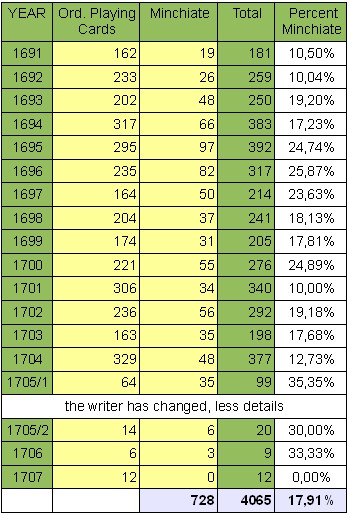
Compare Franco Pratesi's articles: |
|

